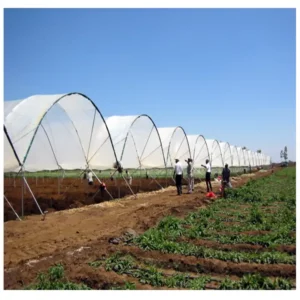Managing a polytunnel greenhouse in regions with varying day lengths throughout the year involves several considerations to ensure optimal conditions for plant growth. The goal is to provide sufficient light during shorter days and manage excess light during longer days.
Here are some strategies for managing the polytunnel greenhouse period in regions with varying day lengths:
- Light Transmission Properties:
- Choose the Right Covering Material: The choice of covering material for the polytunnel plays a crucial role. Select materials with optimal light transmission properties, such as polyethylene films designed to maximize light penetration. Some films also have anti-condensation properties to reduce light diffusion caused by water droplets.
- Lighting Systems:
- Supplemental Lighting: Consider installing supplemental lighting systems to provide additional light during periods of low natural sunlight. High-efficiency artificial lighting, such as LEDs, can help compensate for reduced day length in winter or overcast conditions.
- Light Spectrum Control:
- Adjustable Light Spectrum: Some advanced lighting systems allow growers to adjust the light spectrum. Tailoring the light spectrum to the specific needs of plants can optimize photosynthesis and growth, particularly during periods of limited natural light.
- Light-Responsive Crops:
- Select Crops Based on Day Length Sensitivity: Choose crops that are less sensitive to day length variations or that can adapt to changing light conditions. Some crops are more flexible in their photoperiod requirements, making them better suited for cultivation in regions with varying day lengths.
- Light-Reflective Surfaces:
- Use Reflective Materials: Incorporate light-reflective surfaces within the polytunnel to enhance light distribution. China Polytunnel Greenhouse suppliers Reflective materials on walls or surfaces can redirect and diffuse sunlight, ensuring that it reaches all parts of the crop canopy.
- Light Management Systems:
- Shading and Ventilation: Install shading systems to manage excess light during peak daylight hours. Adjustable shading and proper ventilation help prevent heat buildup and reduce the risk of light stress on plants.
- Automated Environmental Controls:
- Automate Environmental Controls: Implement automated systems to control environmental factors such as temperature, humidity, and ventilation. These systems can be programmed to respond to varying day lengths and adjust conditions accordingly.
- Light Deprivation Techniques:
- Use Light Deprivation Techniques: Employ light deprivation techniques, such as blackout systems, to control the duration of light exposure. This is particularly useful for crops that require specific day lengths for flowering and fruiting.
- Seasonal Crop Planning:
- Plan Crop Rotations: Plan crop rotations based on seasonal changes in day length. Some crops may be better suited for specific times of the year when day lengths align with their growth requirements.
- Monitor Day Length:
- Track Day Length Changes: Keep track of changes in day length throughout the year. This information helps in anticipating and planning for variations in natural light availability.
- Optimize Planting Schedules:
- Adjust Planting Schedules: Adjust planting schedules to align with periods of optimal natural light. This may involve staggered planting or adjusting planting times based on expected day length changes.
- Climate-Adaptive Greenhouse Design:
- Consider Climate-Adaptive Design: Design polytunnels with features that can adapt to varying day lengths, such as adjustable roof and sidewall openings. This flexibility allows for better control over light exposure.
By combining these strategies, growers can effectively manage the polytunnel greenhouse period in regions with varying day lengths, ensuring that plants receive the necessary light for healthy growth and development throughout the changing seasons.
